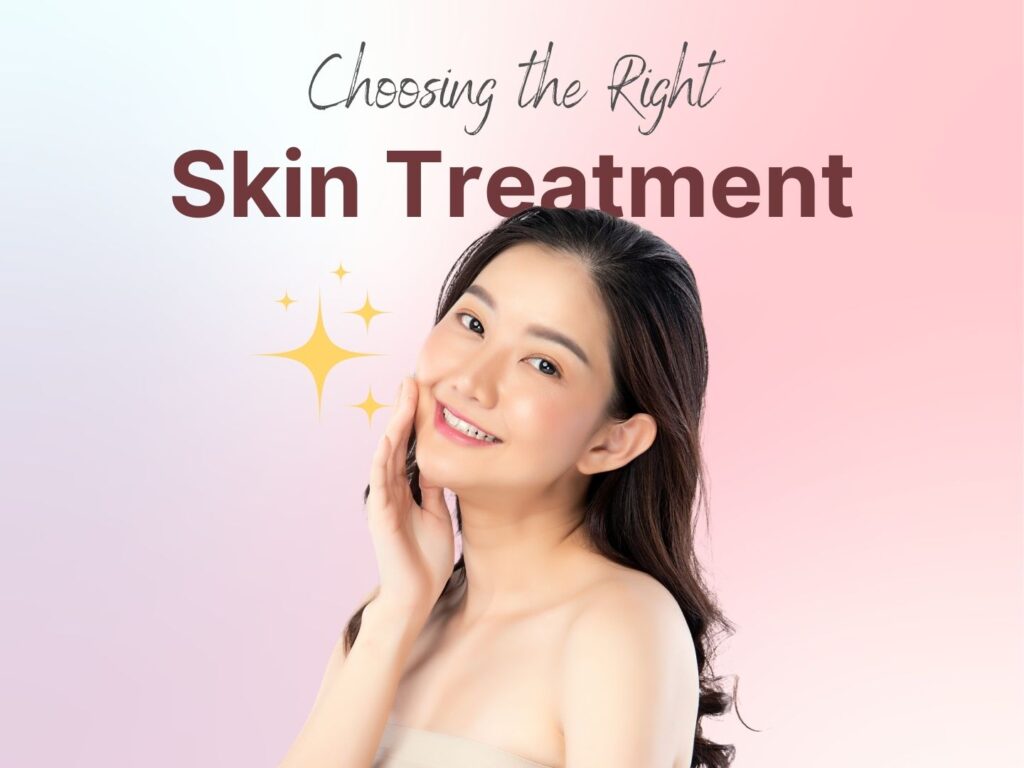Table of Contents
The importance of choosing the right skin treatment lies in its ability to address specific skin concerns, promote overall skin health, and provide a customized approach to skincare. Professional guidance and tailored treatments contribute to a more effective and satisfying skincare experience!
Types of Skin Issue
Active Acne
Presence of inflamed and visibly noticeable pimples, pustules, or nodules on the skin. It is a common skin condition that occurs when hair follicles become clogged with oil and dead skin cells.
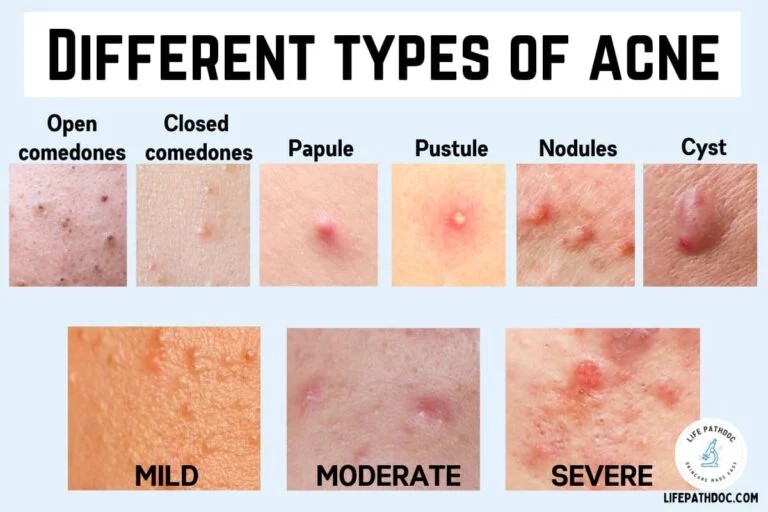
The primary factors contributing to active acne include:
- Excess Sebum Production: Sebaceous glands produce an oily substance called sebum. When these glands produce too much sebum, it can mix with dead skin cells and clog pores, leading to acne.
- Bacterial Infection: The skin is inhabited by bacteria, including Propionibacterium acnes (P. acnes). When pores become blocked, these bacteria can multiply, leading to inflammation and the formation of pimples.
- Inflammation: Inflammatory responses in the skin contribute to the redness, swelling, and tenderness associated with active acne.
- Hormonal Changes: Fluctuations in hormone levels, especially during puberty, menstruation, pregnancy, and certain medical conditions, can stimulate sebum production and contribute to acne development.
- Genetic Factors: A family history of acne may increase the likelihood of developing active acne.
Saggy Skin
Also known as skin laxity, refers to lose or drooping skin that lacks firmness and elasticity (Figure 2). This condition is often a result of aging, as the skin naturally loses collagen and elastin over time, which are proteins that provide structure and elasticity to the skin.
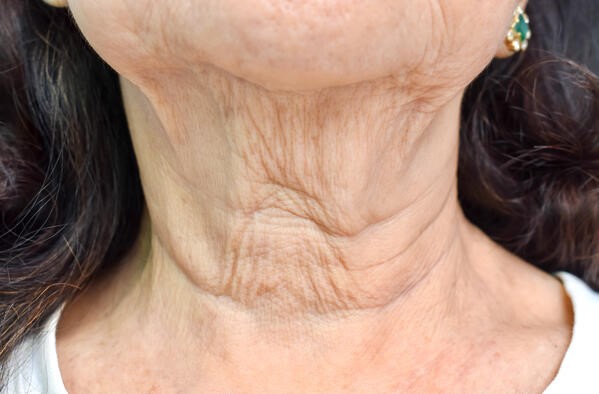
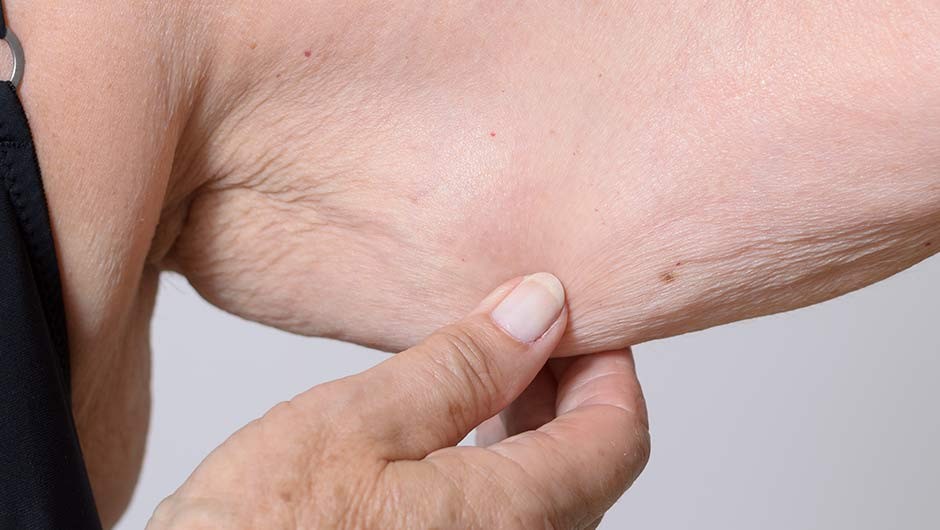
Other factors that can contribute to saggy skin include:
- Weight Loss: Rapid or significant weight loss can lead to saggy skin, as the skin may not have enough time to adapt to the changes in body size.
- Genetics: Some people may be genetically predisposed to have less elastic skin, making them more prone to sagging as they age.
- Sun Exposure: Prolonged exposure to ultraviolet (UV) rays from the sun can damage the collagen and elastin fibers in the skin, accelerating the aging process and contributing to saggy skin.
- Smoking: Smoking has been linked to premature aging of the skin, including a reduction in collagen production, which can contribute to sagging.
- Poor Skin Care: Inadequate skincare practices, such as not moisturizing or not protecting the skin from the sun, can contribute to the development of saggy skin.
Uneven Skin Tone
Uneven skin tone can be an umbrella word for multiple types of skin discoloration caused by sunspots, or post-inflammatory hyperpigmentation (PIH). It can also refer to uneven skin texture, like dry patches, built-up dead skin cells, fine lines, or blotchiness.
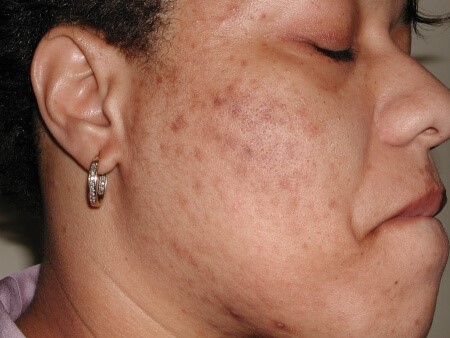

There are many reasons behind different forms of uneven skin tone such as:
- Sun Exposure: When your skin is repeatedly exposed to UV rays, sun damage occurs. Brown or dark spots (known as sunspots) and uneven skin tone develop as a result of excessive melanin production to help protect your skin from UV rays.
- Pollution: Particles and gasses from traffic-related air pollution can penetrate the skin and lead to dark spots, particularly on the face.
- Aging: Older adults may have a more uneven skin tone than younger adults due to sun exposure and the use of medications that may increase skin hyperpigmentation.Some research indicates that hyperpigmentation issues, including post-inflammatory hyperpigmentation and melasma, can occur across all skin types with aging.
- Hormones: Melasma is hormone-related hyperpigmentation and increased melanin production caused by increased hormone stimulation. It’s most commonly experienced by pregnant women (which is why it’s also known as a “pregnancy mask”) or taking contraceptives but can also be a reaction to skincare, make-up, or medications.
- Post-Inflammatory Hyperpigmentation: This is a darkening of the skin due to scarring, which can be caused by acne lesions or skin injury.
Pores
Tiny openings in the skin that allow oil and sweat to reach the surface. They also play a role in regulating body temperature. Pores can be more noticeable on the face, especially in areas where the skin is oilier, such as the forehead, nose, and chin (known as the T-zone).
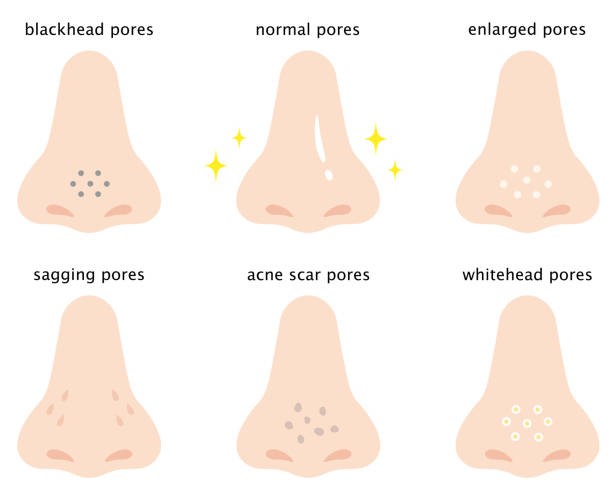
Several factors can contribute to enlarged or more visible pores:
- Genetics: The size of your pores is largely determined by your genetics. If your parents have large pores, you may be more likely to have them as well.
- Oily skin: Excess oil production can contribute to enlarged pores. When oil and dead skin cells accumulate in the pores, they can make them appear larger.
- Aging: As you age, your skin loses collagen and elasticity, which can cause pores to appear larger. Sun damage can also contribute to this effect.
- Sun exposure: Prolonged sun exposure can damage collagen, making the skin less elastic. This can cause pores to appear larger.
- Clogged pores: When pores become clogged with oil, dead skin cells, and other debris, they can stretch and become more visible.
- Poor skincare habits: Not cleansing your face regularly or using harsh skincare products can contribute to pore enlargement.
Pigmentation
It refers to the discoloration of the skin primarily determined by the presence and distribution of melanin. Melanin is a pigment produced by specialized cells called melanocytes. The amount and type of melanin in the skin are influenced by genetic factors, exposure to sunlight, and various hormonal changes.
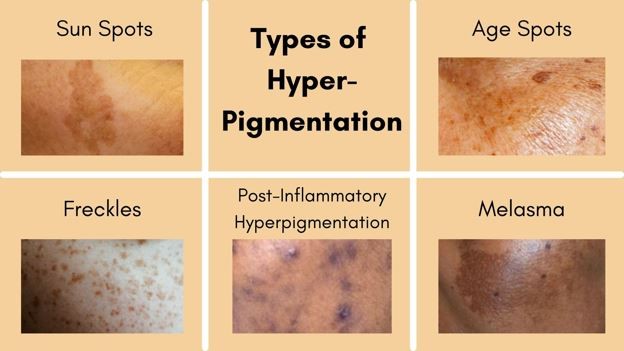
Birthmarks
Present at or shortly after birth. They can vary in size, shape, color, and depth. Birthmarks can be categorized into two main types based on their cause: Vascular Birthmarks and Pigmented Birthmarks.
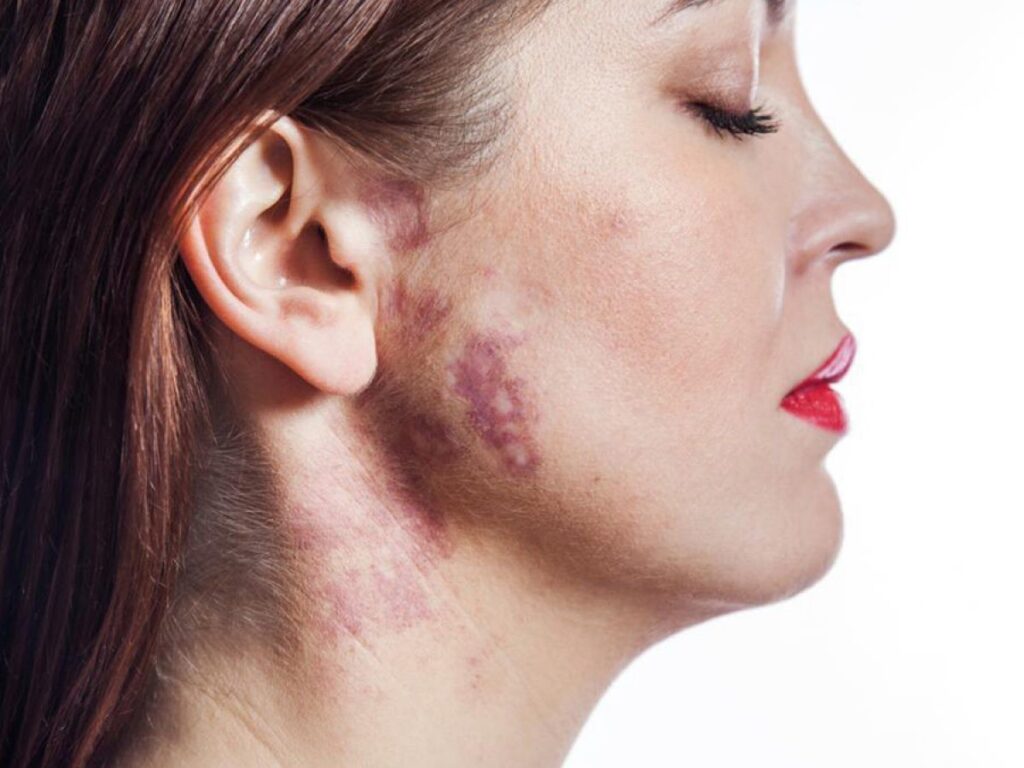
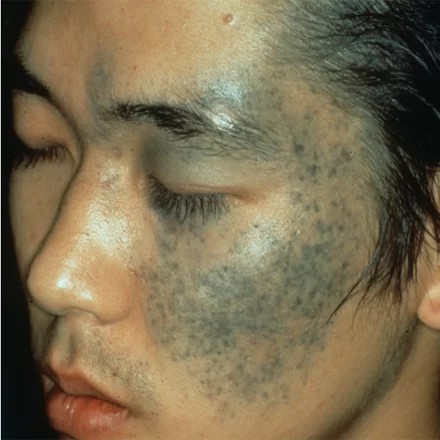
- Vascular Birthmarks: These birthmarks are caused by abnormal blood vessels. They can appear red, pink, or purple and are often raised or bumpy. Examples include port-wine stains and hemangiomas.
- Pigmented Birthmarks: These birthmarks are caused by an overgrowth of pigment cells or an accumulation of melanin. They can appear brown, tan, black, or blue. Common types include moles, cafe-au-lait spots, and Mongolian spots.
It’s important to note that while many birthmarks are harmless and don’t require medical attention, some may need to be monitored or treated, especially if there are changes in size, color, or shape. Additionally, birthmarks that are associated with certain syndromes or medical conditions may require further evaluation and management by a healthcare professional.
Types of Skin Treatment
1. Pro Yellow Laser
Indication:
- Acne: have both anti-inflammatory and antibacterial effects, helping to reduce acne lesions and improve skin texture.
- Pigmented Lesions: treat lentigines (age spots or sun spots) and freckles. The light is absorbed by melanin, the pigment responsible for the color of the skin, and breaks down the pigmented cells.
- Reduction of Erythema (Redness): the anti-inflammatory properties of yellow light are able to reduce redness associated with conditions like rosacea and other inflammatory skin conditions.
- Vascular Lesions: effective in treating vascular lesions, such as telangiectasia (dilated blood vessels), rosacea, and cherry angiomas. The wavelength of yellow light is well-absorbed by hemoglobin, allowing the laser to target and coagulate blood vessels.
Number of sessions needed: 4 to 6 sessions
Downtime: none
How long to expect the result: immediate skin brightening and reduction in redness, rest of the result starts to show in 2 weeks.
2. Fotona Laser
Indication:
- Skin Rejuvenation: stimulates collagen production and improves skin tone and texture, helping to reduce fine lines and wrinkles.
- Acne Treatment: it can target sebaceous glands and reduce oil production, making them useful in the treatment of acne.
- Scar Reduction: this can be used to minimize the appearance of scars, including acne scars and surgical scars.
- Pigmentation Issues: fotona lasers can target and break down pigmented lesions such as age spots, sunspots, and freckles.
- Vascular Lesions: some wavelengths can target blood vessels, making them effective for treating vascular lesions like spider veins and port-wine stains.
- Hair Removal: this can be used for hair removal by targeting the melanin in hair follicles.
- Tattoo Removal: fotona lasers, particularly those with Q-switched technology, can be used for tattoo removal by breaking down the ink particles.
Number of sessions needed: 4 to 6 sessions
Downtime: none
How long to expect the result: immediate skin rejuvenation, the rest starts to show within one month.
3. Picosure
It employs Picosecond Laser pulses to target and break down pigment particles in the skin or stimulate collagen production, depending on the specific treatment goal.
Indication:
- Skin Rejuvenation: used for skin rejuvenation to improve the overall texture and tone of the skin. The laser stimulates collagen and elastin production, helping to reduce the appearance of fine lines, wrinkles, and acne scars.
- Pigmented Lesions: the laser can target and break down excess melanin in the skin, addressing concerns such as sunspots, age spots, and freckles. The fragmented pigment is then naturally eliminated by the body.
- Acne Scars: the laser stimulates collagen and elastin remodeling, helping to improve the texture and appearance of the skin affected by acne scarring.
- Tattoo Removal: break down tattoo ink into smaller particles, making it easier for the body to eliminate them.
Number of sessions needed: 4 to 6 sessions
Downtime: 1 day
How long to expect the result: within one month
4. Chemical Peel
The specific way in which a chemical peel treats skin issues depends on the type of peel and its strength. There are different types of chemical peels, including superficial, medium-depth, and deep peels, each with varying strengths and effects. Superficial peels are milder and may require multiple sessions for optimal results, while deeper peels may provide more dramatic results but often require a more extended recovery period.
Indication:
- Uneven Skin Tone and Texture: exfoliate the outermost layer of the skin, removing dead skin cells help to improve skin texture, promote cell turnover, and reveal fresher, more youthful-looking skin.
- Acne and Acne Scars: the exfoliation helps unclog pores, prevent new acne lesions, and stimulate collagen production, which can improve the texture of acne-scarred skin.
- Hyperpigmentation: the exfoliation process helps to break down excess pigmentation, leading to a more even skin tone.
- Fine Lines and Wrinkles: stimulate collagen production, which can help improve the appearance of fine lines and wrinkles. The exfoliation also contributes to a smoother skin surface.
Number of sessions needed: 4 to 6 sessions
Downtime: minimal to 1 week of redness (depends on the type of peel and strength)
How long to expect the result: within 1 month
5. CO2 Laser
The CO2 laser emits a concentrated beam of light that precisely removes damaged skin tissue layer by layer.
Indication:
- Wrinkles and Fine Lines: CO2 laser resurfacing can reduce the appearance of wrinkles and fine lines by stimulating collagen production and promoting the growth of new, smoother skin.
- Sun Damage, skin tone and texture: The laser can target and remove sun-damaged skin, including age spots, sunspots, and uneven pigmentation, resulting in a more even skin tone.
- Acne Scars: removing damaged skin and promoting collagen remodeling, which helps to fill in and smooth out scarred areas.
- Skin Tightening: CO2 laser resurfacing can have a skin-tightening effect by stimulating collagen production, which improves skin elasticity and firmness.
Number of sessions needed: 4 to 6 sessions
Downtime: 2 weeks
How long to expect the result: within 1 month
6. Sylfirm
Specifically Rejuran Healer or PDRN (Polydeoxyribonucleotide) therapy, is a skin rejuvenation treatment that involves the injection of DNA fragments derived from salmon or other sources into the skin.
Indication:
- Acne: has anti-inflammatory and tissue repairing properties which help to repair damage skin barrier to promote a healthier skin
- Fine Lines and Wrinkles: stimulate collagen production and promote skin renewal.
- Skin Elasticity: It may contribute to improved skin elasticity by supporting the production of collagen and other essential proteins in the skin.
- Skin Texture and tone: Rejuran can help enhance overall skin texture, making the skin smoother and brighter more supple.
- Acne Scars: contribute to collagen remodeling, helping to improve the texture and appearance of scarred skin.
- Skin Hydration: Rejuran is thought to have hydrating properties, which can benefit individuals with dry or dehydrated skin.
Choosing the right skin treatment involves careful consideration of various factors to ensure that the treatment is safe, effective, and suitable for your specific skin needs. It is very important to Identify your skin type and skin conditions you may have, such as acne, rosacea, hyperpigmentation, or aging as different treatments are designed for specific skin types.
Therefore, you can schedule a consultation with a doctor to assess your skin condition and receive professional advice as doctor can recommend personalized treatments based on your skin type, concerns, and medical history.
Frequently Asked Questions (FAQ)
The ideal treatment can vary depending on the seasons and environmental factors. Your skin’s needs may change with the weather, temperature, humidity, and other seasonal factors. Our skin barrier gets disrupted by these environmental changes. Laser treatments can be done year-round as long as with proper sun protection (especially in summer) and adequate skin hydration (especially in colder months). You can consider adding products that contain ceramides and hyaluronic acid and use a more hydrating moisturizer post-laser treatment for better skin recovery.
There is no single treatment that can tackle most skin imperfections all at once as different skin conditions affect different layers of the skin, hence multiple skin treatments are likely to offer maximum benefits.
Individual reactions to skincare treatments can vary, and what works for one person may not work for another. Seeking professional advice and following a careful skincare routine can help manage and alleviate post-treatment irritation or breakouts. If the symptoms are severe or persistent, consult with a healthcare professional for further evaluation and guidance.
Do Consult Kaiteki’s certified Aesthetic Doctors to find out which treatment is suitable for your skin type!

